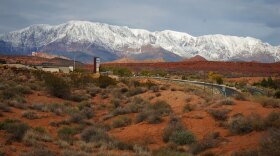-
Northern Utah has a small fraction of the snowpack it typically has this time of year. That’s bad news for ski season and water supplies.
-
October set the stage for Utah to have a solid spring snowmelt runoff. That is, if the state can catch enough snow this winter.
-
Since 2000, heat has become the primary force behind how severe and widespread Western droughts get.
-
Todo lo que ganó el Gran Lago Salado durante el invierno probablemente se disipará para finales del verano. El comisionado del Great Salt Lake, Brian Steed, insta a los habitantes de Utah a ser conscientes del uso que hacen del agua.
-
All of the gains the Great Salt Lake made over the winter will likely dissipate by the end of summer. Great Salt Lake Commissioner Brian Steed urges Utahns to be mindful of their water usage.
-
The mountains that feed the Colorado River with snowmelt are strikingly dry. Many ranges are less than 50% of their average snow for this time of year.
-
Utah’s drought conditions could deteriorate even more as temperatures start to climb. NOAA’s latest seasonal outlook expects above-average heat through July.
-
Between new technology, funding and the Legislature's backing, “Utah is climbing its way to one of the best programs in the world,” said the director of the state's cloud seeding program.
-
The Utah Avalanche Center may have stopped its daily forecasts for the season, but it will continue to post weekly updates on conditions until early May.
-
St. George is on track for its driest winter ever, and southwest Utah’s snowpack stands at record lows.
-
Water experts say cloud seeding deserves more funding and research to measure its impact on the drought-stricken Colorado River basin.
-
Scientists expect La Niña to start by the end of this year. That could fuel a drier-than-normal winter and spell trouble for Utah drought and snowmelt going into 2025.
Play Live Radio
Next Up:
0:00
0:00
Available On Air Stations











